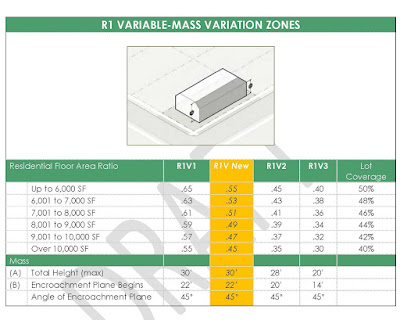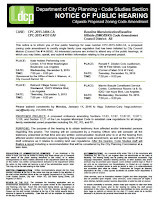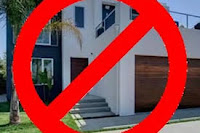Mar Vista Community Council “MVCC” Recommends R1V New Zoning to the Department of City Planning and not the Extremely Restrictive R1V2 Proposal.
 After hearing public comments Wednesday night where the majority of the public speakers were against the City Planning Commission’s proposal for a R1V2 zone change on single-family homes in Mar Vista neighborhoods, the MVCC voted 6 to 2 in favor of recommending R1V New to the City Planning Commission. The new zoning recommendations will replace the existing Interim Control Ordinance “ICO” regarding the Baseline Mansionization Ordinance “BMO” that are set to expire next year. This does not mean the City Council will elect to implement the R1V New zone for Mar Vista but it would be very surprising if they went against the wishes of the Community Council. The R1V2 proposal limits building height and floor area ratio “FAR” significantly compared to the current BMO and would hurt property values. It is an over-reaction to the developers who took advantage of the 20% green building bonus the past seven years and in many cases over-built homes to make more of a profit. The R1V New proposal seems to be a fair compromise which still allows people to remodel and build larger scale homes while curtailing some of the “over-building” by developers. The above chart outlines the options that communities in Los Angeles can choose from. The Department of City Planning will be providing its recommendations to the City Council and people are encouraged to voice their opinions via e-mail to neighborhoodconservation@lacity.org. Here is the link to the full R1 Variation Zone Code Amendment Update as of August 25, 2016
After hearing public comments Wednesday night where the majority of the public speakers were against the City Planning Commission’s proposal for a R1V2 zone change on single-family homes in Mar Vista neighborhoods, the MVCC voted 6 to 2 in favor of recommending R1V New to the City Planning Commission. The new zoning recommendations will replace the existing Interim Control Ordinance “ICO” regarding the Baseline Mansionization Ordinance “BMO” that are set to expire next year. This does not mean the City Council will elect to implement the R1V New zone for Mar Vista but it would be very surprising if they went against the wishes of the Community Council. The R1V2 proposal limits building height and floor area ratio “FAR” significantly compared to the current BMO and would hurt property values. It is an over-reaction to the developers who took advantage of the 20% green building bonus the past seven years and in many cases over-built homes to make more of a profit. The R1V New proposal seems to be a fair compromise which still allows people to remodel and build larger scale homes while curtailing some of the “over-building” by developers. The above chart outlines the options that communities in Los Angeles can choose from. The Department of City Planning will be providing its recommendations to the City Council and people are encouraged to voice their opinions via e-mail to neighborhoodconservation@lacity.org. Here is the link to the full R1 Variation Zone Code Amendment Update as of August 25, 2016
EXTREMELY IMPORTANT: THE NEW BASELINE MANSIONIZATION PROPOSAL “BMO” AND PROPOSED NEW SING-FAMILY ZONE OPTIONS FEELS LIKE AN OVER-REACTION TO OVERZEALOUS DEVELOPERS AND UNFAIR TO HOME OWNERS…YOU MUST VOICE YOUR OPINION!!
The Planning Department is working on two separate, but related, programs to address concerns about the size of houses in the City’s single-family (R1) neighborhoods: (1) amending the Citywide ordinances (BMO and BHO) that regulate the development of single-family homes, and (2) adopting new single-family zone options that will be applied to neighborhoods currently subject to Interim Control Ordinances (ICOs).
As a resident of Mar Vista, I despise the big, unimaginative cookie-cutter boxes erected all over Los Angeles, especially those with roof-top decks that take away the privacy of neighbors in smaller homes. I hear and agree with these valid complaints and changes need to be made! At the same time, what is currently being proposed, especially for the new single-family zone option for Mar Vista/East Venice and Kentwood (Westchester) is extremely restrictive and irrational.
As a realtor I must disclose that I occasionally work with developers. However, I have NOT been happy with their aggressive push on maxing square footage and using un-imaginative structures to increase profit margins. Unfortunately, this has created the uproar against “McMansions” and the people who are ultimately going to pay the price with highly restrictive square footage rules is the regular homeowner while also de-valuing the land they currently own. Many growing families will not be able to remodel as they intended when they purchased their home under the previous BMO ordinance.
The latest proposal for the Mar Vista/East Venice/Kentwood neighborhoods is extremely restrictive. Until a recent moratorium (ICO), homeowners/developers were allowed to build up to 50% of a lot size with a 20% and sometimes 25% allowable green building bonus. The ICO got rid of the green
building bonus which was a reasonable response to the over-building. However, the loud voices of the anti-mansionization movement have frightened the City Council into making deeper cuts into the size of a house that can be built. The proposed new single-family zones for Mar Vista/East Venice and Kentwood would involve a zone change from R1-1 to R1V2 and would regulate floor area, depending on lot size, to between only 35% and 45%. Currently, if one owns a 7,001 sq. ft. lot in Mar Vista, they can build a 3,500 sq. ft. house. Under the new R1V2 proposal, they would only be able to build up to 41% of the lot size meaning the house can only be 2,870 sq. ft. This is almost a 20% reduction in size and that doesn’t take into account if you have an attached garage where 200 sq. ft. of that would eat into your overall square footage, further reducing your livable square footage to 2,670 sq. ft.!
To give you some perspective on the size of these cuts, see the table below which also takes into account the financial impact this would have on most families largest financial investment. Land value is paramount in Los Angeles and principles will pay less money for land in which less square footage can be built on.
*valuation is based on overall market knowledge and figuring the home is in very good condition. Current land value for a 7,001 sq. ft. lot is around $1.35M+ and will drop overnight if the proposal is passed.
I would also like to address what many homeowners in my neighborhood have expressed to me. They didn’t realize the severity of this proposal and frankly many of them are dual income families with children without the time or energy to show up to the public hearings about this topic.
Attached Garages: Since when would an area in which you park your car be counted against the
livable square footage? It is NOT fair to assume that everyone uses an attached garage as extra living space. Attached garages are essential for safety, especially when a spouse is a frequent business traveler. Attached garages allow for people to build a home that creates a larger backyard which is an essential component for maximizing California living and one’s own land value. I have yet to hear a rationale argument as to why an attached garage should be counted against the allowable floor area of a lot especially when non-attached garage square footage is considered exempt.
Caring for elderly parents/grandparents: People are living much longer. Even though society is having less kids then they did 20+ years ago, the size of families living together is INCREASING. Due to medical and health advancements, some households will have four living generations in them. “By 2025, as many as 25% of the U.S. population will be in multi-generational households and the demand for a different kind of residential property will accelerate over the next decade to meet this demand” (Strategic Advantage Real Estate newsletter). When you combine this with astronomically high rents forcing children to live at home longer than ever, does it really make sense to further restrict a homeowner in regards to what they can do with their property? Also, as a father and someone who grew up with five siblings, I have a serious problem with many of the proponents for the new proposal arbitrarily telling people they can make due in smaller houses. They don’t know the specific needs of a certain families that might require more space, etc. We all have different needs and that should be respected.
Why make the ugly boxes even more valuable?: By passing the proposed ordinance, it will have the unfortunate impact of making those unsightly/over-built shoe boxes even more valuable. They will never be torn down since the homeowner would have to build a significantly smaller house. Since these homes will not have any competition, their value will end up trading at premium prices…so the people with the homes that everyone loves to hate will be in an even better financial position.
Can we just meet in the middle? We need changes but they don’t need to be this dramatic. Why not a proposal that targets the problem areas, but is not an arbitrary reduction in allowable square feet, such as the following proposal:
*A 50% floor area ratio without any bonuses. The 45% proposed in the recent BMO is also too restrictive.
*Create a second floor ratio or an architectural requirement that takes away the boxy nature of larger homes. *Attached garages should NOT be counted against the floor area ratio.
*Roof-Top decks would not be allowed unless explicitly approved by neighbors that would be impacted.
FYI: Pacific Palisades residents have loudly voiced their opposition to this and those outside of the Coastal Zone will have an allowable floor area between 55% to 65%.
LET YOUR VOICE BE HEARD (written submissions are encouraged!):
Contact: Christine Saponara, Department of City Planning-
christine@saponara.lacity.org
Phyllis Nathanson, Department of City Planning- Phyllis.Nathanson@lacity.org/ phone: 213.978.1474
FILL OUT THE ZONING INPUT FORM: Provide your address and e-mail and answer three questions. Shouldn’t take more than two minutes unless you add extensive comments.
For more information check out the Neighborhood Conservation Update web-page.
PUBLIC HEARING INFORMATION
Mar Vista/ East Venice, Kentwood and Pacific Palisades
When: Tuesday, September 13, 2016
Time: Open House at 5:30 p.m., Presentation at 6:30 p.m., Public Hearing at 6:30 p.m.
Where: Henry Medina Building, 11214 Exposition Blvd. Los Angeles, CA 90064
Lower Council District 5, Inner Council District 5, Beverlywood and Fairfax
When: Tuesday, September 20, 2016
Time: Open House at 5:30 p.m., Presentation at 6:30 p.m., Public Hearing at 6:30 p.m.
Where: Henry Medina Building, 11214 Exposition Blvd. Los Angeles, CA 90064
Amendments to the Los Angeles Mansionization regulations will most likely be approved in May…
 According to the Los Angeles city planning office, it looks like the new Baseline (BMO) and hillside (BHO) mansionization ordinances will be recommended for approval by city council in May. Despite strong opposition from developers and property owners who are looking to enhance/expand their properties, the city planning office states that about 85% of the public input was for stricter building rules. Some changes may still be made to the proposal but the bulk of it looks like it will be approved. This is a positive thing for areas that have been impacted developers over-building but it is frustrating for normal property owners with nice homes that need to expand due to a growing family, etc. A one size fits all approach isn’t necessarily fair as the needs of one family differ from those of others.
According to the Los Angeles city planning office, it looks like the new Baseline (BMO) and hillside (BHO) mansionization ordinances will be recommended for approval by city council in May. Despite strong opposition from developers and property owners who are looking to enhance/expand their properties, the city planning office states that about 85% of the public input was for stricter building rules. Some changes may still be made to the proposal but the bulk of it looks like it will be approved. This is a positive thing for areas that have been impacted developers over-building but it is frustrating for normal property owners with nice homes that need to expand due to a growing family, etc. A one size fits all approach isn’t necessarily fair as the needs of one family differ from those of others.
Here are some highlights from the proposed update you should be aware of:
*Attached garages will be considered usable living square footage. Garage space has never been considered livable space until this proposal. The typical garage is around 400 square feet. If you want to build a 2,000 sq. ft. house with an attached garage, the house itself would only be 1,600 sq. ft. (quick note- Most homebuyers prefer an attached garage for safety and comfort. Attaching a garage to the house, especially in the front, maximizes backyard space allowing families to take full advantage of the wonderful Southern California weather.)
*Properties with a lot size of 9,000 sq. ft. or less can only be 45% of the lot size with an allowable green building bonus of 20% if your garage is NOT attached. Currently it is 50% with a 20% allowable green building bonus. This is a 10% decrease in sq. ft. and an attached garage would make the decrease more significant.
*Homes on lots above 9,000 sq. ft. can only be 40% of the lot size with an allowable green building bonus of 20% if you garage is NOT attached. Currently, it is 45%.
*Hillside homes will no longer have grading exemptions underneath the footprint of the structure.
*A second story can only be 60% of the first floor footprint. Right now, it is 75%. Under the new proposal, if you have a 1,200 sq. ft. first story, the second story addition can only 720 sq. ft. making it very difficult to have two bedrooms. Homeowners looking to expand will probably have to rebuild to have a correct/proper floorplan.
*The planning department did NOT perform an economic impact report.
*The original BMO/BHO took over 7 years to develop and it was a collaborative effort with real estate professionals. The proposed amendments took a little over a year without any collaboration.
*New amendments could go into effect as early as May 2016.
Personally speaking, I believe you can curtail overzealous builders without being this restrictive. Cut out some loopholes that allow for the 20% building bonus or require further set-backs but telling someone that where they park their car is considered living space and that 2,300 sq. ft (including attached garage) is enough on a 6,000 sq. ft. lot is unfair.
From an economic perspective, limiting the square footage that can be built from the original BMO/BHMO will negatively impact home values, especially for older homes that need to be remodeled. The cost of land is so expensive throughout most of Los Angeles that a regular homeowner or developer is going to add square footage or build a new house for the investment to make sense. The increase in square footage along with the overall rehabilitation of the property, done in a tasteful manner, increases the value of the neighborhood.
In terms of counting attached garage space as living space, it’s no secret some property owners are using their garage as living space whether it is attached or detached. This is a violation of the city code and it’s not fair for the city to punish homeowners who utilize an attached garage properly due to their inability to enforce the improper use of a garage. Furthermore, if people are using garages as living space, it is an example the typical needs for families are outgrowing the current residence, especially with an aging population in which caring for elderly parents in the home for many years is increasing. It doesn’t seem to make much sense to further restrict the size of a home when families could be forced to expand in non-traditional ways.
 You can e-mail the neighborhoodconservation@lacity.org for a draft of the full proposal.
You can e-mail the neighborhoodconservation@lacity.org for a draft of the full proposal.
It is not too late to express your thoughts to the city planning office- hagu.solomon-cary@lacity.org and contact your local city councilman as well. In talking to local residents, it seems most typical homeowners are not being heard and it is a vocal minority that is creating much of the noise.
Close some of the loopholes currently being exploited and figure out ways to control overzealous developers but this current proposal seems a bit restrictive.





